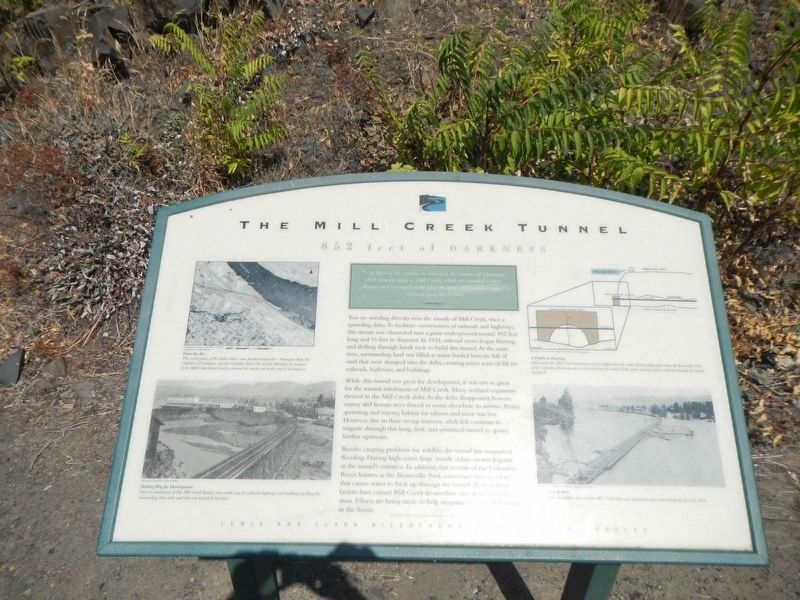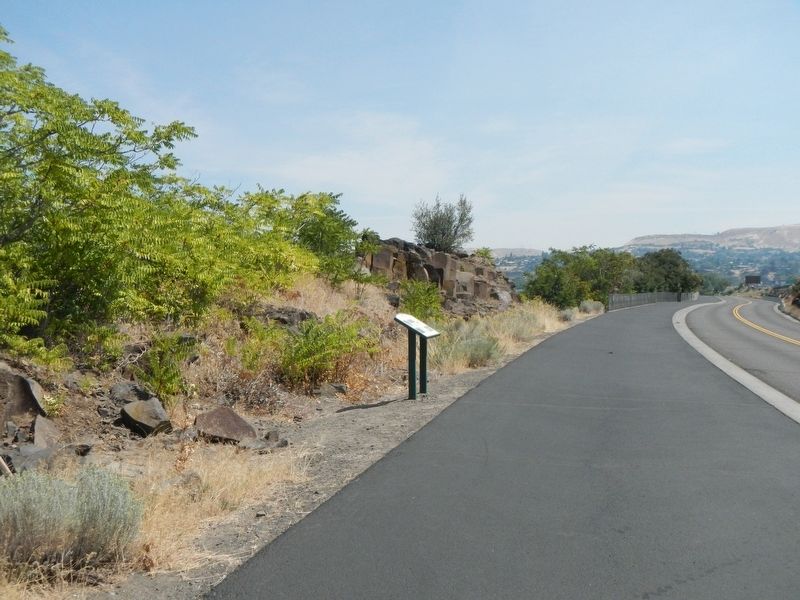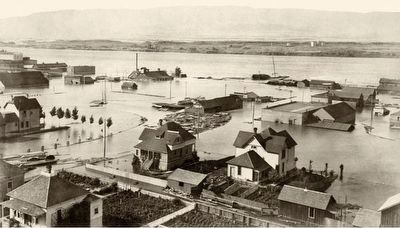The Dalles in Wasco County, Oregon — The American West (Northwest)
The Mill Creek Tunnel

Photographed By Barry Swackhamer, August 13, 2020
1. The Mill Creek Tunnel Marker
Captions: (top left) From the Air... This aerial photo of the Dalles shows some familiar landmarks - Thompson Park, the Chamber of Commerce, and the Columbia River. The red line illustrates the location of the Mill Creek Tunnel, built to channel the stream and make way for development.; (bottom left) Making Way for Development. Prior to construction of the Mill Creel Tunnel, crews made way for railroads, highways, and buildings by filling the surrounding delta with sand that was hauled in by trains.; (top right) A Profile in Flooding, Water enters the Mill Creek Tunnel just six feet higher than the outlet. During high water times the Bonneville Pool of the Columbia River can rise to a level covering the mouth of the outlet causing water to back up through the tunnel and flood.; The Flood of 1894. The Dalles downtown area and Mill Creek delta were inundated with water during the Flood of1894.
You are standing directly over the mouth of Mill Creek, once a sprawling delta. To facilitate construction of railroads and highways this creek was channeled into a giant underground tunnel 852 feet long and 16 feet in diameter. In 1934, railroad crews began blasting and drilling through basalt rock to build this tunnel. At the same time, surrounding land was filled as trains hauled boxcars full of sand that were dumped into the delta, creating seven acres of fill for railroads, highways, and buildings.
While this tunnel was great for development, it was not so great for the natural inhabitants of Mill Creek. Many wetland organisms thrived in the Mill Creek delta. As the delta disappeared, beavers, osprey, and herons were forced to move elsewhere. Prime spawning and rearing habitat for salmon and trout was lost. However, due to their strong instincts, adult fish continued to migrate through this long, dark and unnatural tunnel to spawn further upstream.
Besides creating problems for wildlife, the tunnel has intensified flooding. During high water, large woody debris creates logjams at the tunnel's entrance. In addition, this section of the Columbia River, known as the Bonneville Pool, sometimes rises to a level that caused water to back up through the tunnel. Both of these factors have caused Mill Creek to overflow into downtown building areas. Efforts and being made to help minimize the effects of flooding in the future.
Erected by Columbia River Gorge National Scenic Area.
Topics. This historical marker is listed in these topic lists: Disasters • Man-Made Features • Natural Features • Waterways & Vessels. A significant historical date for this entry is April 13, 1806.
Location. 45° 36.375′ N, 121° 11.23′ W. Marker is in The Dalles, Oregon, in Wasco County. Marker is on West 1st Street near Union Street, on the right when traveling west. Touch for map. Marker is at or near this postal address: 801 West 1st Street, The Dalles OR 97058, United States of America. Touch for directions.
Other nearby markers. At least 8 other markers are within walking distance of this marker. Archaeology of Lewis & Clark (within shouting distance of this marker); Establishing Rock Fort (about 300 feet away, measured in a direct line); Rumor of Attack (about 300 feet away); The Lewis & Clark Expedition (about 300 feet away); Trade Center for 10000 Years (about 300 feet away); The White Man Legend (about 300 feet away); Importance of Salmon (about 300 feet away); Original Wasco County Courthouse (approx. 0.2 miles away). Touch for a list and map of all markers in The Dalles.
Credits. This page was last revised on October 22, 2020. It was originally submitted on October 22, 2020, by Barry Swackhamer of Brentwood, California. This page has been viewed 459 times since then and 50 times this year. Photos: 1, 2, 3. submitted on October 22, 2020, by Barry Swackhamer of Brentwood, California.

